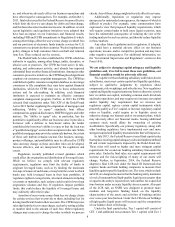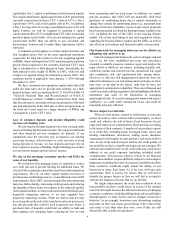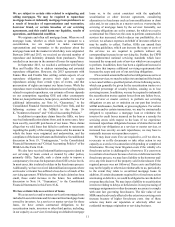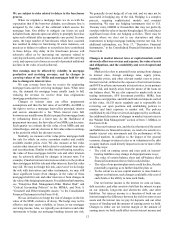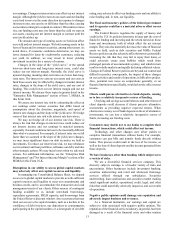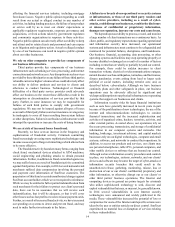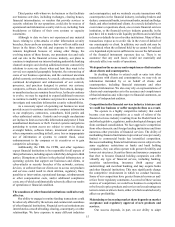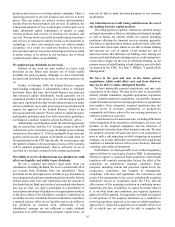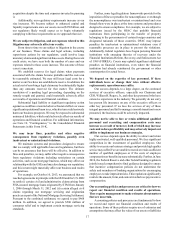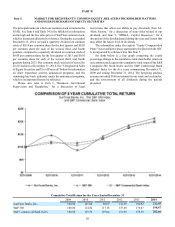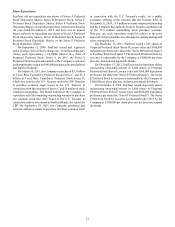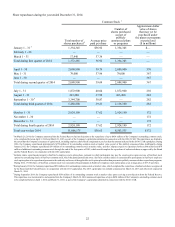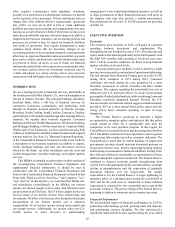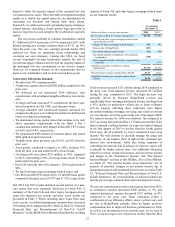SunTrust 2014 Annual Report Download - page 40
Download and view the complete annual report
Please find page 40 of the 2014 SunTrust annual report below. You can navigate through the pages in the report by either clicking on the pages listed below, or by using the keyword search tool below to find specific information within the annual report.17
acquisition despite the time and expenses invested in pursuing
it. Additionally, our regulatory requirements increase as our
size increases. We become subject to enhanced capital and
liquidity requirements once our assets exceed $250 billion, and
our regulators likely would expect us to begin voluntarily
complying with those requirements as we approach that size.
We are subject to litigation, and our expenses related to this
litigation may adversely affect our results.
From time to time we are subject to litigation in the course
of our business. These claims and legal actions, including
supervisory actions by our regulators, could involve large
monetary claims and significant defense costs. During the recent
credit crisis, we have seen both the number of cases and our
expenses related to those cases increase. The outcome of these
cases is uncertain.
We establish reserves for legal claims when payments
associated with the claims become probable and the costs can
be reasonably estimated. We may still incur legal costs for a
matter even if we have not established a reserve. In addition, the
actual cost of resolving a legal claim may be substantially higher
than any amounts reserved for that matter. The ultimate
resolution of a pending legal proceeding, depending on the
remedy sought and granted, could materially adversely affect
our results of operations and financial condition.
Substantial legal liability or significant regulatory action
against us could have material adverse financial effects or cause
significant reputational harm to us, which in turn could seriously
harm our business prospects. We may be exposed to substantial
uninsured liabilities, which could adversely affect our results of
operations and financial condition. For additional information,
see Note 19, “Contingencies,” to the Consolidated Financial
Statements in this Form 10-K.
We may incur fines, penalties and other negative
consequences from regulatory violations, possibly even
inadvertent or unintentional violations.
We maintain systems and procedures designed to ensure
that we comply with applicable laws and regulations, but there
can be no assurance that these will be effective. In addition to
fines and penalties, we may suffer other negative consequences
from regulatory violations including restrictions on certain
activities, such as our mortgage business, which may affect our
relationship with the GSEs and may also damage our reputation,
and this in turn might materially affect our business and results
of operations.
For example, on October 10, 2013, we announced that we
reached agreements in principle with the HUD and the U.S. DOJ
to settle (i) certain civil and administrative claims arising from
FHA-insured mortgage loans originated by STM from January
1, 2006 through March 31, 2012 and (ii) certain alleged civil
claims regarding our mortgage servicing and origination
practices as part of the National Mortgage Servicing Settlement.
Pursuant to the combined settlement, we agreed to pay $468
million. In addition, we agreed to provide $500 million of
consumer relief and to implement certain mortgage servicing
standards.
Further, some legal/regulatory frameworks provide for the
imposition of fines or penalties for noncompliance even though
the noncompliance was inadvertent or unintentional and even
though there were in place at the time systems and procedures
designed to ensure compliance. For example, we are subject to
regulations issued by the OFAC that prohibit financial
institutions from participating in the transfer of property
belonging to the governments of certain foreign countries and
designated nationals of those countries. OFAC may impose
penalties for inadvertent or unintentional violations even if
reasonable processes are in place to prevent the violations.
Additionally, federal regulators have begun pursuing financial
institutions with emerging theories of recovery under the
Financial Institutions Reform, Recovery, and Enforcement Act
of 1989 (FIRREA). Courts may uphold significant additional
penalties on financial institutions, even where the financial
institution had already reimbursed the government or other
counterparties for actual losses.
We depend on the expertise of key personnel. If these
individuals leave or change their roles without effective
replacements, operations may suffer.
Our success depends, to a large degree, on the continued
services of executive officers, especially our Chairman and
CEO, William H. Rogers, Jr., and other key personnel who have
extensive experience in the industry. We generally do not carry
key person life insurance on any of the executive officers or
other key personnel. If we lose the services of any of these
integral personnel and fail to manage a smooth transition to new
personnel, the business could be adversely impacted.
We may not be able to hire or retain additional qualified
personnel and recruiting and compensation costs may
increase as a result of turnover, both of which may increase
costs and reduce profitability and may adversely impact our
ability to implement our business strategies.
Our success depends upon the ability to attract and retain
highly motivated, well-qualified personnel. We face significant
competition in the recruitment of qualified employees. Our
ability to execute our business strategy and provide high quality
service may suffer if we are unable to recruit or retain a sufficient
number of qualified employees or if the costs of employee
compensation or benefits increase substantially. Further, in June
2010, the Federal Reserve and other federal banking regulators
jointly issued comprehensive final guidance designed to ensure
that incentive compensation policies do not undermine the
safety and soundness of banking organizations by encouraging
employees to take imprudent risks. This regulation significantly
restricts the amount, form, and context in which we pay incentive
compensation.
Our accounting policies and processes are critical to how we
report our financial condition and results of operations.
They require management to make estimates about matters
that are uncertain.
Accounting policies and processes are fundamental to how
we record and report our financial condition and results of
operations. Some of these policies require use of estimates and
assumptions that may affect the value of our assets or liabilities



